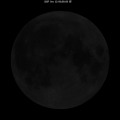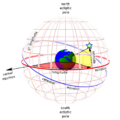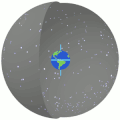Epoch (astronomy) (redirect from J2000.0)
for January 0.9235, 1950 TT Besselian years (see below), e.g., 1950.0 or B1950.0 for January 0.9235, 1950 TT Julian years, e.g., J2000.0 for January 1...
24 KB (3,437 words) - 15:52, 6 March 2025
Equinox (celestial coordinates) (section J2000.0)
equinox and of the epoch. The currently used standard equinox and epoch is J2000.0, which is January 1, 2000 at 12:00 TT. The prefix "J" indicates that it...
14 KB (1,750 words) - 02:20, 16 December 2024
duration is 365.256363004 days (365 d 6 h 9 min 9.76 s) (at the epoch J2000.0 = January 1, 2000, 12:00:00 TT). Today the mean tropical year is defined...
53 KB (5,829 words) - 13:00, 25 May 2025
0 + ( A 1 × T ) + ( A 2 × T 2 ) {\displaystyle A=A_{0}+(A_{1}\times T)+(A_{2}\times T^{2})} ; T in centuries (cy) is 36,525 days from epoch J2000.0....
24 KB (3,023 words) - 03:22, 12 May 2025
once around the ecliptic. It equals 365.256363004 ephemeris days for the J2000.0 epoch, or a little over 366 sidereal days. The sidereal year differs from...
4 KB (467 words) - 11:16, 30 May 2025
or synodic month, is the period from one new moon to the next. At the J2000.0 epoch, the average length of a lunation is 29.53059 days (or 29 days, 12...
17 KB (1,888 words) - 10:52, 27 May 2025
secularly and periodically. The quantities given are the values at the instant J2000.0 of the secular variation, ignoring all periodic variations. aphelion =...
17 KB (1,860 words) - 12:44, 24 March 2025
calculated: ε = 23°26′21.448″ − 46.8150″ T − 0.00059″ T2 + 0.001813″ T3 where hereafter T is Julian centuries from J2000.0. JPL's fundamental ephemerides have...
33 KB (3,110 words) - 18:07, 17 April 2025
are: Mean equinox of a standard epoch (usually the J2000.0 epoch, but may include B1950.0, B1900.0, etc.) is a fixed standard direction, allowing positions...
14 KB (1,331 words) - 02:25, 16 December 2024
Right ascension (Epoch J2000.0) Declination (Epoch J2000.0) Discovery date Designation Stellar class Mass (M☉) 1,560±10 0.478±0.005 Gaia BH1 (TIC 125470397)...
25 KB (1,311 words) - 15:13, 26 April 2025
proper motion in the equatorial coordinate system (of a given epoch, often J2000.0) are given in the direction of right ascension (μα) and of declination...
23 KB (2,453 words) - 22:10, 1 May 2025
away from the plane of the Milky Way. On photographic plates taken with the 0.7 m Schmidt telescope at the Tonantzintla Observatory in Mexico, it appeared...
17 KB (1,840 words) - 23:22, 24 May 2025
to the southwest of the Alpha Centauri AB pair. It is currently 12,950 AU (0.2 ly) from AB, which it orbits with a period of about 550,000 years. Proxima...
106 KB (9,923 words) - 11:10, 20 May 2025
standard epoch is J2000.0, which is January 1, 2000 at 12:00 TT. The prefix "J" indicates that it is a Julian epoch. Prior to J2000.0, astronomers used...
12 KB (1,187 words) - 11:39, 18 February 2025
commonly used are: Mean equinox of a standard epoch (usually J2000.0, but may include B1950.0, B1900.0, etc.) is a fixed standard direction, allowing positions...
17 KB (1,657 words) - 07:37, 20 March 2025
and ecliptic of J2000.0. The TOP2013 solution is the best for the motion over the time interval −4000...+8000. Its precision is of a few 0.1″ for the four...
15 KB (2,029 words) - 09:15, 27 May 2025
definitions come with an epoch to specify the date of the rotation axis; J2000.0 is the current standard. An analogous concept applies to other planets:...
10 KB (1,159 words) - 01:54, 21 March 2025
data Epoch J2000.0 Equinox J2000.0 Constellation Dorado Right ascension 05h 26m 00.7s Declination −66° 04′ 35″ Apparent magnitude (V) 24.0 Characteristics...
5 KB (578 words) - 11:11, 2 April 2025
with a B meaning the coordinates are for the 1950.0 epoch. All new pulsars have a J indicating 2000.0 coordinates and also have declination including minutes...
18 KB (1,776 words) - 00:44, 26 May 2025
temperature of 7,415 K. Sigma Octantis is a Delta Scuti variable, varying by about 0.03 magnitudes every 2.33 hours. It is thought to pulsate only in the fundamental...
12 KB (1,059 words) - 17:18, 18 August 2024
Observation data (J2000.0 epoch) Right ascension 07h 44m 30.0s Declination −23° 51′ 24″ Distance 3.38 kly (1.037 kpc) Apparent magnitude (V) 6.0 Apparent dimensions (V)...
8 KB (710 words) - 11:06, 18 July 2024
2011-11-16. A metallicity of −0.22 indicates that they have the following proportion of metals compared to the Sun: 10−0.22 = 0.603, or 60%. Viallet, M.;...
24 KB (2,135 words) - 18:46, 27 April 2025
Star catalogue (redirect from USNO-B1.0)
years. USNO-B1.0 is believed to provide all-sky coverage, completeness down to V = 21, 0.2 arcsecond astrometric accuracy at J2000.0, 0.3 magnitude photometric...
47 KB (5,497 words) - 21:23, 11 May 2025
the boundary of Virgo is similarly far. Observation data Epoch J2000.0 Equinox J2000.0 Constellation Leo Right ascension 11h 30m 14.51774s Declination...
12 KB (854 words) - 19:23, 24 May 2025
calculated to orbit each other every 104.02128±0.00016 days, with a semimajor axis of 111.11±0.10 million km (0.74272±0.00069 AU), roughly the distance between...
72 KB (7,678 words) - 17:00, 26 May 2025
Ca and Cb, separated by 0.6 AU. The 6th magnitude Beta Tucanae D, is another A-type star which is separated by approximately 0.38 arcseconds (16 AU) from...
14 KB (1,090 words) - 20:44, 18 May 2025
Schwarzschild radius of 295.25 billion kilometres (2,000 astronomical units; 0.031 light-years), 50 times the distance from the Sun to Pluto. A circumference...
16 KB (1,709 words) - 08:07, 12 May 2025
reddish, semiregular variable star whose apparent magnitude, varying between +0.0 and +1.6, with a main period near 400 days, has the widest range displayed...
178 KB (18,820 words) - 11:59, 29 May 2025
each before or after J2000.0. For example, the future epoch J2100.0 will be exactly 36,525 days (one Julian century) from J2000.0 at 12:00 TT on January...
7 KB (900 words) - 05:25, 23 April 2025
−29° 00′ 28.118″ (J2000). Rounded to the same number of digits as the table, 17h 45.7m, −29.01° (J2000), there is an offset of about 0.07° from the defined...
15 KB (1,383 words) - 10:24, 1 August 2024






















